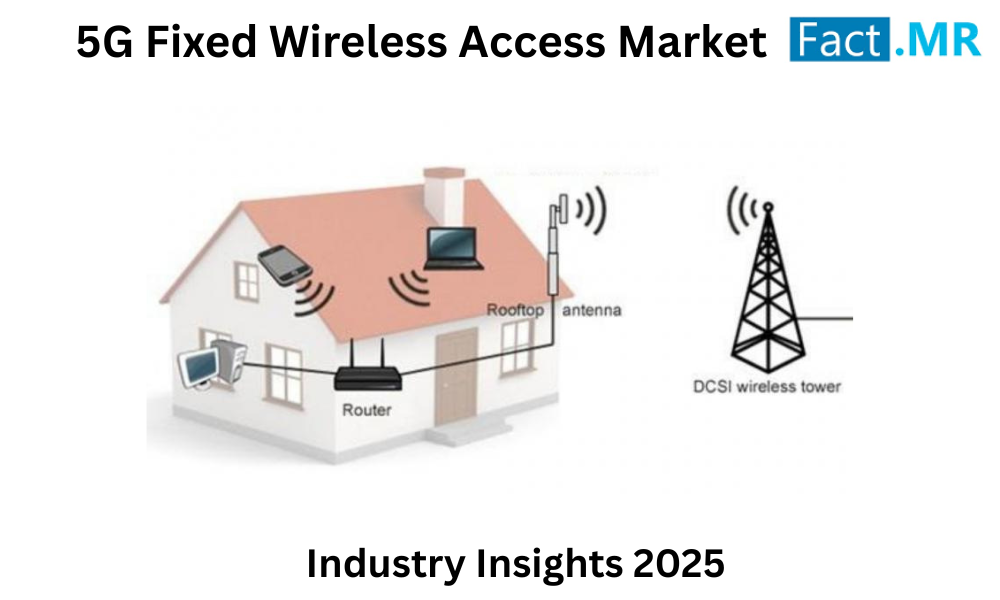The global 5G fixed wireless access market is experiencing explosive growth, valued at USD 35.9 billion in 2024 and projected to reach USD 670.3 billion by 2034. This remarkable expansion reflects a compound annual growth rate (CAGR) of 34% over the forecast period from 2024 to 2034. The surge is primarily driven by the escalating demand for high-speed, low-latency internet connectivity, broad network coverage, and cost-effective broadband alternatives to traditional fiber infrastructure. As telecom operators and governments prioritize rural and underserved areas, 5G FWA emerges as a game-changer for enabling seamless digital access. This market evolution is further fueled by strategic government initiatives, such as the U.S. ‘Internet for All’ program launched in May 2022, and technological advancements in radio access networks, positioning 5G FWA as a pivotal solution for smart cities, IoT proliferation, and remote work ecosystems.
Market Segmentation and Trends
The 5G fixed wireless access market is segmented by offering, operating frequency, demography, application, and region, providing a nuanced understanding of its structure. By offering, segments include hardware (essential for base stations and user equipment) and services (encompassing deployment, maintenance, and optimization), with hardware leading due to infrastructure investments. By operating frequency, SUB-6 GHz 5G dominates with a projected 55% market share by 2034, valued at USD 368.7 billion (CAGR 32.8%), offering balanced coverage and penetration for urban and suburban deployments, while 24-39 GHz and above 39 GHz bands cater to high-capacity needs.
By demography, urban areas lead for dense connectivity demands, but semi-urban and rural segments are fastest-growing, addressing sparse population challenges through extended range solutions. By application, residential broadband holds 33% share by 2034 (USD 221.2 billion, CAGR 33.2%), driven by home internet upgrades, while commercial, industrial, and government sectors focus on enterprise connectivity and smart infrastructure.
Regionally, North America commands 24.3% share by 2034, fueled by aggressive 5G deployments. Market trends include the convergence of FWA with M2M/IoT for applications like telemedicine and smart parking, the rise of mmWave for ultra-high speeds in urban cores, and hybrid models combining FWA with fiber for redundancy. Sustainability efforts emphasize energy-efficient antennas, aligning with green telecom goals.
Full Market Report Available for Delivery. For Purchase or Customization, Please Request Here: https://www.factmr.com/connectus/sample?flag=S&rep_id=7382
Driving Factors Behind Market Growth
The 5G fixed wireless access market is propelled by multiple interconnected drivers. The pressing need for high-speed internet in underserved areas, particularly rural and semi-urban zones, positions FWA as a viable alternative to costly fiber rollouts. Government initiatives, like the U.S. ‘Internet for All’ program allocating billions for broadband expansion, accelerate infrastructure development.
Technological advancements in radio technology and spectrum allocation enable superior performance, with SUB-6 GHz offering wide coverage and mmWave delivering gigabit speeds. The proliferation of IoT and smart city applications—such as pollution monitoring, traffic management, and security—demands reliable, low-latency connectivity. Cost-effectiveness, with deployment up to 9 miles from towers as seen in Ericsson’s 2021 Mediacom partnership, reduces barriers for operators. Additionally, rising remote work and digital education post-pandemic amplify residential demand.
Recent Developments and Key Players
The 5G fixed wireless access market is highly competitive, with key players emphasizing innovation, partnerships, and spectrum advancements. Recent developments underscore rapid commercialization. In February 2021, Qualcomm launched the Gen 2 Qualcomm Fixed Wireless Access Platform, enhancing router capabilities for faster 5G adoption. June 2021 saw Ooredoo and Nokia introduce reliable 5G/4G FWA solutions in Oman, targeting broadband gaps. In August 2021, Ericsson partnered with Mediacom to deploy FWA in rural America, covering up to 9 miles per tower for expanded access.
Key players include Nokia Corporation, Inseego Corp., Samsung Electronics Co. Ltd., Qualcomm Technologies Inc., Huawei Technologies Co. Ltd., Intel Corporation, Ericsson, MediaTek Inc., Mimosa Networks Inc., and Verizon Communications Inc. Competitor analysis reveals a focus on hardware-software integration and strategic alliances. Companies are investing in R&D for mmWave efficiency and forming operator partnerships to scale deployments, ensuring compliance with global spectrum standards.
Regional Insights and Opportunities
North America leads with a 24.3% market share by 2034, driven by U.S. investments in rural broadband; the U.S. market, valued at USD 3.8 billion in 2024, is projected to reach USD 74.3 billion by 2034 (CAGR 34.6%), holding 45.6% of North America’s share. East Asia follows closely, with China contributing 47.5% of the region’s share, growing from USD 3.9 billion in 2024 to USD 73.6 billion by 2034 (CAGR 34%), supported by smart city initiatives.
South Korea’s demand surges at a 34.9% CAGR, benefiting from advanced 5G infrastructure. Emerging regions like Latin America and the Middle East & Africa offer substantial opportunities through digital inclusion programs. Japan’s market grows at 34.6% CAGR, focusing on urban FWA for high-density areas. Partnerships with local telcos and spectrum auctions are key to unlocking these markets.
Challenges and Future Outlook
The 5G fixed wireless access market faces challenges, including signal blockage by physical obstacles like buildings and trees, limiting non-line-of-sight performance and necessitating denser tower deployments. Higher component costs and manufacturing precision for mmWave circuitry pose economic hurdles, particularly in rural expansions.
However, the future outlook is highly optimistic, with opportunities in hybrid FWA-fiber models and AI-optimized networks. As 5G ecosystems mature and investments in small cells proliferate, the market is well-positioned for exponential growth, revolutionizing broadband access through 2034.
Check out More Related Studies Published by Fact.MR:
5G Core Market5G Services Market
Contact:
US Sales Office
11140 Rockville Pike
Suite 400
Rockville, MD 20852
United States
Tel: +1 (628) 251-1583, +353-1-4434-232
Email: [email protected]
About Fact.MR
We are a trusted research partner of 80% of fortune 1000 companies across the globe. We are consistently growing in the field of market research with more than 1000 reports published every year. The dedicated team of 400-plus analysts and consultants is committed to achieving the utmost level of our client’s satisfaction.

